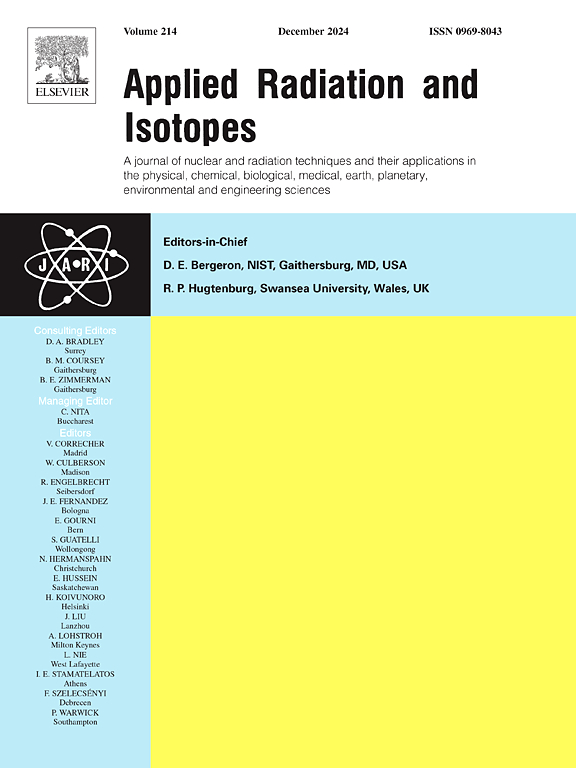Feasibility of radioisotope production by neutron spectral selection: Mathematical and computational approaches
IF 1.6
3区 工程技术
Q3 CHEMISTRY, INORGANIC & NUCLEAR
引用次数: 0
Abstract
The main goal is to investigate the theoretical feasibility of producing neutron-rich radioisotopes in a Selective Spectral Resonant Selector (RSS), targeting radiative neutron capture reactions in precursor nuclides. The reaction rates of the precursor nuclides and contaminants were evaluated and converted into normalized activity per unit mass, assuming an arbitrary input intensity. Two distinct RSS MB and MR configurations were considered in the problem-solving approach. RSS MB with a neutron source of 108 n.s−1, 3d exposure time, provides the specific activities (MB.g−1) of close to 896 to 153Sm; 306, 177Lu; 804, 188Re; 1190 166Ho; while RSS MR provides 36 to 177Lu; 10, 169Yb; 135, 192Ir, as example. As a benchmark, the comparative performance of RSS and traditional radioisotope production was assessed based on an activation potential parameter η, providing values 3.2M, 1.1k, 620 for 153Sm,177Lu,188Re, respectively, with RSS MR achieving significantly higher potential compared to nuclear reactors. The reaction 187Re(n,γ)188Re in a natural abundant target cannot be used in a nuclear reactor due to large contamination; however, RSS MR demonstrates the capability to produce 188Re with 60 times the activity of the contaminant 186Re. The specific activities and benchmark parameters from different radionuclides demonstrates the effectiveness of the RSS for radioisotope production.
中子谱选择生产放射性同位素的可行性:数学和计算方法
主要目的是研究在选择性光谱共振选择器(RSS)中产生富中子放射性同位素的理论可行性,以前体核素中的辐射中子捕获反应为目标。假设任意输入强度,评估前体核素和污染物的反应速率并将其转换为单位质量的归一化活度。在解决问题的方法中考虑了两种不同的RSS MB和MR配置。中子源为108 n.s−1的RSS MB,三维曝光时间,提供了接近896至153Sm的比活度(MB.g−1);306、177路;804年、188年再保险;1190 166 ho);而RSS MR则提供36至177Lu;169 yb;例如135,192ir。作为基准,RSS与传统放射性同位素生产的比较性能基于活化电位参数η进行评估,153Sm、177Lu、188Re的活化电位分别为3.2M、1.1k、620,与核反应堆相比,RSS MR的电位明显更高。天然富集靶中的187Re(n,γ)188Re反应由于污染大,不能用于核反应堆;然而,RSS MR显示产生188Re的能力,其活性是污染物186Re的60倍。不同放射性核素的具体活度和基准参数证明了RSS生产放射性同位素的有效性。
本文章由计算机程序翻译,如有差异,请以英文原文为准。
求助全文
约1分钟内获得全文
求助全文
来源期刊

Applied Radiation and Isotopes
工程技术-核科学技术
CiteScore
3.00
自引率
12.50%
发文量
406
审稿时长
13.5 months
期刊介绍:
Applied Radiation and Isotopes provides a high quality medium for the publication of substantial, original and scientific and technological papers on the development and peaceful application of nuclear, radiation and radionuclide techniques in chemistry, physics, biochemistry, biology, medicine, security, engineering and in the earth, planetary and environmental sciences, all including dosimetry. Nuclear techniques are defined in the broadest sense and both experimental and theoretical papers are welcome. They include the development and use of α- and β-particles, X-rays and γ-rays, neutrons and other nuclear particles and radiations from all sources, including radionuclides, synchrotron sources, cyclotrons and reactors and from the natural environment.
The journal aims to publish papers with significance to an international audience, containing substantial novelty and scientific impact. The Editors reserve the rights to reject, with or without external review, papers that do not meet these criteria.
Papers dealing with radiation processing, i.e., where radiation is used to bring about a biological, chemical or physical change in a material, should be directed to our sister journal Radiation Physics and Chemistry.
 求助内容:
求助内容: 应助结果提醒方式:
应助结果提醒方式:


